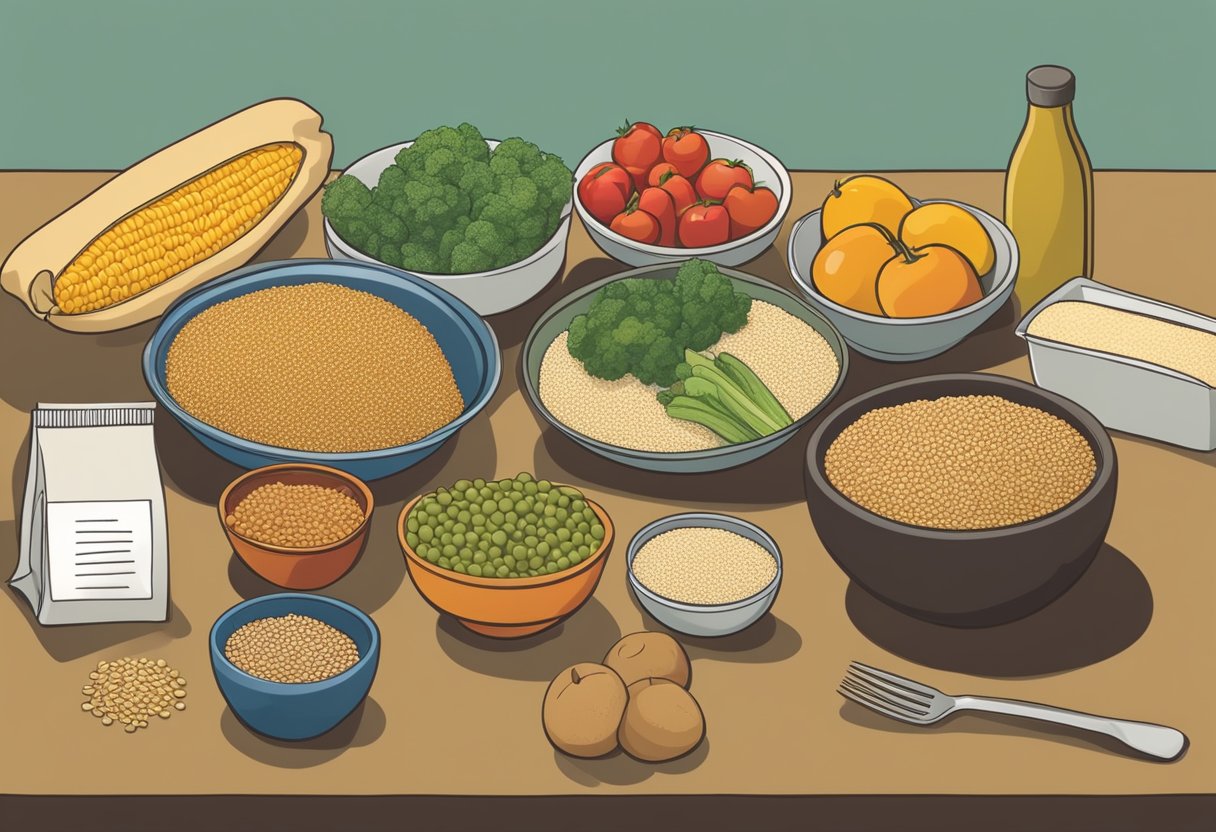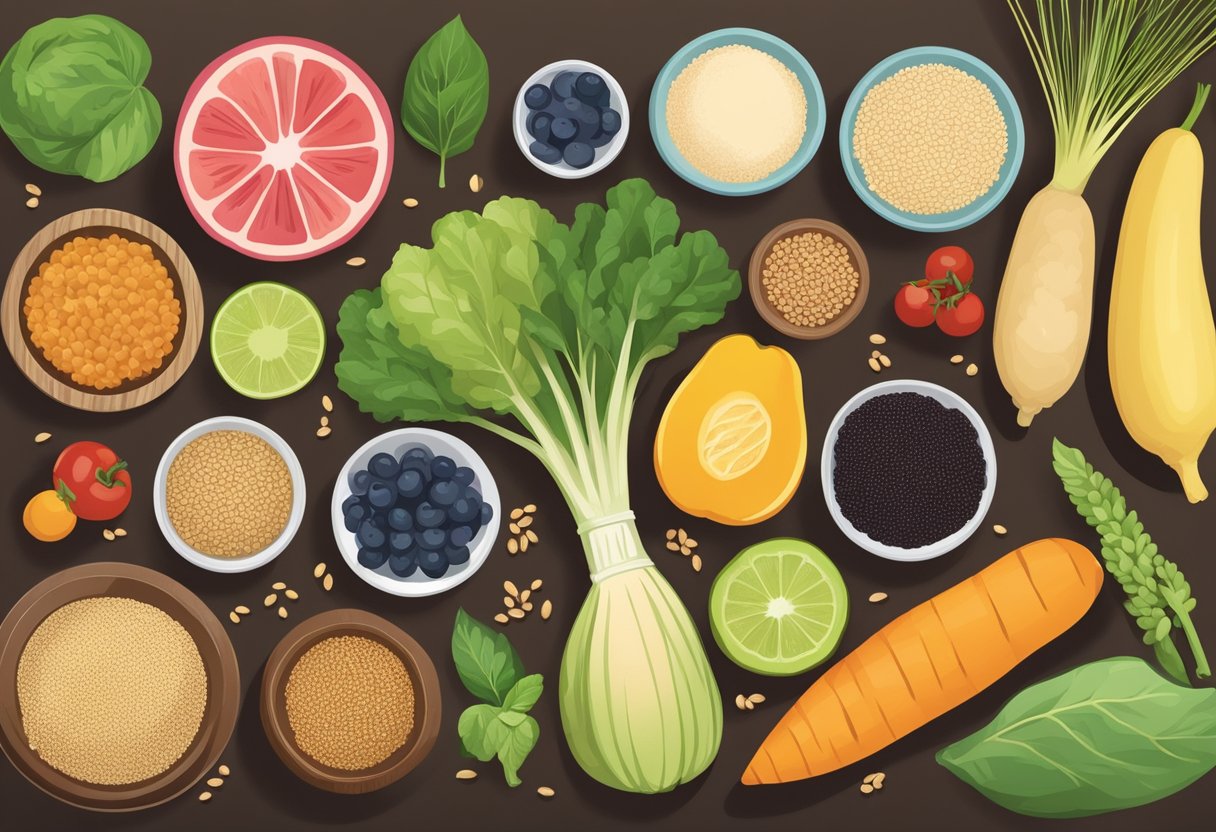The adoption of a gluten-free diet is often critical for individuals with celiac disease or gluten sensitivity, as it is the primary treatment to avoid the discomfort and potential harm caused by gluten consumption. Gluten is a type of protein found in grains such as wheat, barley, and rye, and eliminating it from one’s diet can alleviate and prevent symptoms associated with these conditions. However, embarking on this dietary change requires cautious planning to ensure nutritional needs are met, as gluten-containing grains are ubiquitous in many traditional diets and are often a major source of certain vitamins and minerals.

A gluten-free diet not only helps manage symptoms for those with celiac disease or gluten sensitivity but also introduces the opportunity to explore nutrient-rich gluten-free grains and alternatives. In the context of a Mediterranean dietary pattern, which emphasizes fruits, vegetables, lean proteins, and healthy fats, a gluten-free variant focuses on naturally gluten-free foods like rice, quinoa, and corn, alongside ample fresh produce and seafood. This combination can support healthful eating by providing essential nutrients that may otherwise be lacking in a less balanced gluten-free regimen.
Key Takeaways
- A gluten-free diet is essential for managing celiac disease and gluten sensitivity.
- It is important to seek nutrient-rich gluten-free alternatives within a Mediterranean dietary framework.
- Proper planning and education are key to ensuring a nutritionally adequate gluten-free diet.
Table of Contents
Understanding Celiac Disease and Gluten Sensitivity
Navigating the complexities of celiac disease and gluten sensitivity is critical for adopting a successful gluten-free Mediterranean diet. Understanding these conditions and their symptoms can lead to better dietary choices and improved health.
What Is Celiac Disease?
Celiac disease is an autoimmune disorder where the ingestion of gluten leads to damage in the small intestine. Gluten, a protein found in wheat, barley, and rye, triggers an immune response in people with celiac disease. This response damages the microvilli, which are tiny hair-like projections in the small intestine responsible for nutrient absorption. A definitive diagnosis often requires a combination of serologic tests for specific antibodies and a biopsy of the small intestine.
Non-Celiac Gluten Sensitivity
Non-celiac gluten sensitivity (NCGS) involves a negative reaction to gluten that is not autoimmune like celiac disease. Individuals with NCGS experience symptoms similar to celiac disease but typically without the intestinal damage. Unlike celiac disease, there are no specific biomarkers, like antibodies or intestinal damage, that can reliably diagnose non-celiac gluten sensitivity.
Identifying Symptoms of Gluten Intake
Symptoms of both celiac disease and gluten sensitivity can include, but are not limited to, gastrointestinal issues such as diarrhea, constipation, and bloating, as well as non-GI symptoms like headaches and fatigue. These symptoms can vary greatly in presentation and severity. A gluten-free Mediterranean diet, avoiding gluten-containing grains such as wheat, barley, and rye, can help manage these symptoms and promote gut health.
Basics of a Gluten-Free Diet
Adopting a gluten-free diet primarily involves eliminating gluten, a protein complex found in certain grains, to manage health issues like celiac disease. This section will provide an understanding of what constitutes a gluten-free diet and guidance on foods to include and avoid.
Defining Gluten-Free
A gluten-free diet excludes all forms of gluten, typically found in wheat, barley, and rye. Any food or ingredient derived from these grains must be avoided unless labeled specifically as gluten-free. For proper management of gluten-sensitive conditions, vigilance in avoiding gluten contamination is crucial.
Foods to Include
The foundation of a gluten-free diet can be naturally gluten-free foods such as:
- Grains and Starches: Rice, quinoa, corn, tapioca, millet, amaranth, teff, arrowroot, buckwheat
- Proteins: Eggs, meat, poultry, fish, legumes
- Fruits and Vegetables: All types (fresh, frozen, canned, dried) without added sauces or preservatives
- Dairy Products: Most milk, butter, cheese, and yogurt (avoiding those with added flavors or ingredients that could contain gluten)
- Nuts and Seeds: In their natural form without breading or flavorings
These foods form the basis of a nutritious, gluten-free Mediterranean diet, which also emphasizes consumption of healthy fats like olive oil and a higher intake of plant-based foods.
Foods to Avoid
Avoiding gluten necessitates keeping away from foods containing the following:
- Wheat-Based Foods: Breads, pastas, cereals, baked goods, beers, and other items made with wheat, barley, or rye
- Processed Foods: Many processed items can contain gluten as a thickening agent or additive
Reading labels is essential to ensure that none of the ingredients are derived from gluten-containing grains. Those following a gluten-free Mediterranean diet should also be cautious of processed gluten-free products that may not align with the whole food focus of the diet, such as those high in sugar or saturated fats.
Nutritional Implications

Adopting a gluten-free Mediterranean diet requires careful consideration to ensure nutritional adequacy. Individuals must be aware of the potential risks for nutrient deficiencies while finding ways to maintain a balanced diet rich in essential micronutrients.
Risk of Nutrient Deficiencies
The elimination of gluten-containing grains can lead to deficiencies in iron, calcium, and B vitamins like folate. Whole grains, often avoided on a gluten-free diet, are a primary source of dietary fiber and micronutrients. Gluten-free alternatives may not always offer equivalent nutritional value, necessitating careful meal planning to ensure sufficiency.
Maintaining a Balanced Diet
A balanced gluten-free Mediterranean diet should focus on incorporating a variety of fruits, vegetables, lean proteins, and gluten-free grains. Inclusion of foods such as quinoa and buckwheat can help maintain adequate levels of fiber and protein. Regular consumption of olive oil provides beneficial fats, and choosing seafood or legumes supplies iron and protein without the need for gluten-containing products.
Importance of Micronutrients
Micronutrients are critical for overall health; they include vitamins and minerals that the body needs in small quantities. The gluten-free Mediterranean diet embraces nutrient-dense foods like leafy greens for calcium and iron, nuts and seeds for vitamin E, and citrus fruits for vitamin C. To prevent micronutrient deficiencies, individuals should prioritize these nutrient-rich options.
Gluten-Free Grains and Alternatives
When following a gluten-free diet, it’s essential to be aware of grains that are naturally gluten-free and suitable alternatives to wheat, barley, and rye. These alternatives not only enable individuals to maintain a diverse and balanced diet but also support those who choose a gluten-free lifestyle, such as those adhering to a gluten-free Mediterranean diet.
Naturally Gluten-Free Grains
Naturally gluten-free grains provide essential nutrients without the risk of gluten contamination. Quinoa, millet, and buckwheat offer a high-protein alternative to conventional grains. They are versatile and can be used in a variety of dishes. Quinoa, in particular, is a complete protein, containing all nine essential amino acids. Sorghum and teff are grains that are rich in fiber and antioxidants. They contribute to a well-rounded gluten-free Mediterranean diet, offering options for those seeking whole grain benefits.
Gluten-Free Cereals and Breads
Cereals and breads that are gluten-free are often made using corn, rice, and oat. These grains must be certified gluten-free to ensure they have not been cross-contaminated during processing. Corn can be found in forms such as polenta and cornmeal, staples in Mediterranean cuisine. Gluten-free rice cereals offer a light breakfast option, while oats provide a heartier, fiber-rich choice.
Cooking and Baking Alternatives
Cooking and baking on a gluten-free diet requires creativity and the use of alternative flours. Amaranth, bean, soy, and potato flours are commonly used in gluten-free recipes. Tapioca starch is derived from cassava roots and adds a chewy texture to gluten-free baked goods. These alternatives not only enrich one’s diet with variety but also offer the opportunity to explore traditional Mediterranean dishes tailored to gluten-free needs.
Considerations for Special Populations
Special populations such as those attempting weight loss, individuals with diabetes, and vulnerable groups like children and the elderly have unique nutritional needs that must be addressed when adopting a gluten-free diet.
Gluten-Free Diet for Weight Loss
For individuals facing obesity or seeking weight loss, a gluten-free diet may contribute to a reduction in calorie intake, especially if it leads to the elimination of high-calorie gluten-containing foods. However, they should not rely solely on the gluten-free label as a marker of healthiness; instead, they ought to focus on incorporating whole foods like fruits, vegetables, and lean proteins. A gluten-free Mediterranean diet can offer a balanced approach, as it emphasizes natural, nutrient-rich foods and minimizes processed gluten-free products that are often high in calories and sugar.
Gluten-Free Diet and Diabetes
Patients with diabetes must manage carbohydrate intake and maintain blood sugar levels. A gluten-free diet can be beneficial if it includes a variety of nutrient-dense, low-glycemic foods. The Mediterranean diet again serves as a good model, providing sources of carbohydrates like quinoa and rice that have a more gradual impact on blood glucose. It is crucial for diabetic patients to plan meals carefully to ensure that they are getting adequate nutrition while controlling their diabetes.
Gluten-Free for Children and the Elderly
Children and the elderly have distinct nutritional requirements for growth and maintaining health. There is evidence that a balanced gluten-free diet can be both safe and nutritious for these groups if it includes adequate sources of fiber, vitamins, and minerals. When planning a gluten-free diet for these populations, one should prioritize foods like fruits, vegetables, lean meats, and gluten-free grains that are naturally rich in nutrients. The inclusion of Mediterranean diet principles can help ensure a diverse intake of essential nutrients, aiding in healthy development for children and supporting well-being in the elderly.
Potential Challenges and Solutions
Adopting a gluten-free Mediterranean diet can greatly benefit individuals with celiac disease or gluten sensitivity, but it comes with its own set of challenges. Below are specific strategies to tackle these issues and maintain a healthy lifestyle.
Avoiding Cross-Contamination
When preparing gluten-free dishes such as pasta and pizza, meticulous care in the kitchen is crucial to prevent cross-contamination. One strategy is to use separate cookware exclusively for gluten-free cooking. Additionally, individuals should be vigilant when purchasing processed foods and thoroughly read food labels to ensure that products are certified gluten-free and not produced in a facility that processes wheat or gluten-containing ingredients.
Dealing With Social Situations
Social events can pose difficult scenarios for those on a gluten-free Mediterranean diet. A practical solution is to communicate dietary restrictions to the host in advance. One can also offer to bring a gluten-free dish, like a quinoa salad or gluten-free bread, to share. This ensures there’s a safe option available while also introducing others to gluten-free alternatives.
Finding Gluten-Free Options When Dining Out
Diners can still enjoy restaurants while maintaining a gluten-free Mediterranean diet by taking proactive steps. They should research establishments that offer gluten-free menu options, or ones known for serving naturally gluten-free Mediterranean foods, such as grilled fish or vegetables. Communication is key: they should be clear about their dietary needs to the restaurant staff to ensure safe meal preparation and avoid the risk of cross-contamination.
The Role of Healthcare Professionals

Healthcare professionals play a vital role in guiding individuals through the intricacies of a gluten-free Mediterranean diet, ensuring both improved health outcomes and maintenance of quality of life.
Working With a Registered Dietitian
Working with a registered dietitian is crucial for those adopting a gluten-free Mediterranean diet. Dietitians develop personalized meal plans that ensure the intake of essential nutrients often lacking in gluten-free diets, such as iron, fiber, and B vitamins. They also provide resources and strategies for making nutritious choices within the confines of the diet, such as incorporating a variety of fruits, vegetables, lean proteins, and gluten-free grains.
Regular Check-Ups With a Physician
Regular appointments with a physician help monitor an individual’s overall health and the long-term impact of a gluten-free Mediterranean diet on their well-being. Physicians can assess the diet’s effectiveness and make necessary adjustments to avoid potential deficiencies. They are also integral in providing access to support groups and other resources to assist individuals in managing their dietary restrictions and fostering a sense of community and support.
Label Reading and Safe Foods
Navigating a gluten-free diet requires a careful examination of food labels and an awareness of foods that are inherently gluten-free. Understanding these can be especially important for adhering to a gluten-free Mediterranean diet, which emphasizes whole foods, healthy fats, and fresh produce.
Understanding Food Labels
On a gluten-free Mediterranean diet, individuals need to pay close attention to food labels to ensure they avoid gluten. The key is to look for labels stating the product is “gluten-free,” as this implies compliance with FDA regulations. However, in Mediterranean cuisine, where olive oils, legumes, and seafood feature prominently, these items are naturally gluten-free. Oats are a gray area, as they may be contaminated with gluten unless specifically labeled gluten-free.
Safe Foods to Enjoy:
- Fruits & Vegetables: All fresh, frozen, or canned without additional sauces or seasonings.
- Nuts & Seeds: Unprocessed and not flavored with potential gluten-containing additives.
- Legumes: Plain beans, lentils, and chickpeas.
- Seafood: Fresh or frozen without marinating sauces.
- Dairy: Milk, cheese, and yogurt in their natural forms without additives.
It’s imperative to not only read the label for ingredients but also to look for certifications or statements regarding the handling of the product to rule out cross-contamination.
Identifying Hidden Sources of Gluten
Gluten can lurk in unexpected places, and individuals following a gluten-free Mediterranean diet need to be aware of hidden sources. Common hidden sources include flavorings, malt, and sauces, which can be made from gluten-containing ingredients. Products like soups may also contain gluten as a thickening agent.
Potential Hidden Gluten Sources:
- Flavoring: Natural and artificial flavorings may contain gluten unless otherwise stated.
- Malt: Made from barley, a common ingredient in cereals and snacks.
- Souces & Soups: May use wheat flour as a thickener.
To avoid gluten in these areas, individuals should look for products with ingredient lists that clearly state “gluten-free” or provide a breakdown that shows the absence of gluten-containing elements. Additionally, opting for homemade versions of sauces and soups can ensure they align with a gluten-free Mediterranean lifestyle.
Innovations in Gluten-Free Products
Recent trends in food science have led to significant enhancements in gluten-free products, catering to those with celiac disease or gluten sensitivities. The availability of diverse gluten-free options has increased, and products such as bread, pasta, and cereal now feature improved nutritional profiles and flavors that align with a Mediterranean diet.
Advances in Gluten-Free Flours and Baking
Manufacturers have made significant strides in the production of gluten-free flours. These flours combine ingredients like almond, coconut, and ancient grains to provide a rich nutritional value and facilitate healthier versions of conventional baked goods. For instance, quinoa and amaranth flours, staples in Mediterranean cuisine, are now commonly used to enhance the fiber content in gluten-free bread and cereal products.
In baking, innovative techniques have emerged to mimic the texture and rise that gluten traditionally imparts. Ingredients such as xanthan gum and psyllium husk improve the elasticity and structure of gluten-free doughs, making them more similar to their wheat-based counterparts in consistency and taste.
Gluten-Free Food Enhancements
Gluten-free products no longer lag behind in flavor or variety. Pasta made from legumes like lentils and chickpeas is not only rich in protein but also offers a flavor profile that complements the Mediterranean diet‘s emphasis on plant-based ingredients.
Furthermore, condiments such as gluten-free soy sauce and fermented products add depth to dishes without the gluten content. Ice cream and other desserts have benefited from innovations, including the use of gluten-free thickeners and stabilizers to achieve a creamy texture without compromising on taste. This progress in food technology allows those following a gluten-free Mediterranean diet to enjoy a full range of flavors without dietary restrictions.
Managing Health Risks

Adopting a gluten-free diet, particularly one inspired by Mediterranean eating habits, addresses the health risks associated with gluten-related disorders. However, vigilance in maintaining nutritional adequacy is important to prevent other health risks.
Long-Term Risks of Gluten Consumption
For individuals with celiac disease or non-celiac gluten sensitivity, continued consumption of gluten can lead to chronic health issues. These issues include intestinal damage resulting in malabsorption of essential nutrients, which may in turn contribute to nutritional deficiencies. Gluten consumption may also exacerbate symptoms such as diarrhea, constipation, bloating, and extraintestinal manifestations like headaches and skin rash. Adhering to a strict gluten-free diet is the only known treatment to manage these risks effectively.
Monitoring Health and Nutritional Status
Individuals adhering to a gluten-free Mediterranean diet should have regular follow-ups to monitor their health and nutritional status:
- Nutritional Deficiencies: Regular blood tests are recommended to detect deficiencies in iron, calcium, fiber, and B vitamins.
- Bone Density: Since malabsorption can lead to osteopenia or osteoporosis, bone density screenings are advised.
- Metabolic Health: They should monitor for signs of metabolic syndrome, characterized by a group of conditions including high blood pressure, high blood sugar, excess body fat around the waist, and abnormal cholesterol levels.
- Digestive Symptoms: Even on a strict diet, they should be vigilant about persistent symptoms such as bloating, constipation, or diarrhea, which may indicate accidental gluten intake or another underlying issue.
Regular consultations with healthcare professionals can help manage the risk of these adverse health effects while ensuring the diet remains palatable and nutritionally balanced.
Frequently Asked Questions
Transitioning to a gluten-free diet raises important nutritional concerns. This section addresses some critical inquiries individuals often have regarding the health and nutritional impacts of a gluten-free lifestyle.
What are the common nutritional deficiencies associated with a gluten-free diet?
Individuals consuming a gluten-free diet often encounter deficiencies in nutrients such as B-vitamins, calcium, iron, zinc, magnesium, and fiber. These nutrients are prevalent in whole grain products that contain gluten, which are excluded on a gluten-free diet.
How can someone on a gluten-free diet ensure they receive adequate fiber intake?
To ensure adequate fiber intake on a gluten-free diet, one can incorporate high-fiber, gluten-free grains such as quinoa, buckwheat, and brown rice. Additionally, consuming a variety of fruits, vegetables, nuts, and seeds enhances fiber intake.
What are the health benefits of a gluten-free diet for individuals without celiac disease?
While a gluten-free diet is imperative for individuals with celiac disease, some people without it may experience reduced inflammation and improved gastrointestinal health. It’s important to note that health benefits vary and one should consult a healthcare professional before making dietary changes.
What grains can be included in a gluten-free diet without compromising nutritional value?
Grains like quinoa, millet, buckwheat, teff, sorghum, and amaranth are gluten-free and offer robust nutritional profiles, including essential vitamins, minerals, and protein. Including these grains helps maintain the nutritional value of a gluten-free diet.
How can one maintain a balanced gluten-free diet while avoiding cross-contamination?
Preventing cross-contamination involves meticulous food preparation and ensuring that food surfaces, utensils, and storage containers are gluten-free. It is also crucial to read labels and be vigilant when dining out to uphold a balanced, uncontaminated gluten-free diet.
What steps should beginners take to transition to a nutritionally complete gluten-free diet?
Beginners should consult a dietitian specialized in gluten-free nutrition to create a balanced diet plan. One should focus on naturally gluten-free foods, learn to read labels for hidden gluten, and gradually replace gluten-containing grains with nutrient-dense gluten-free alternatives.



